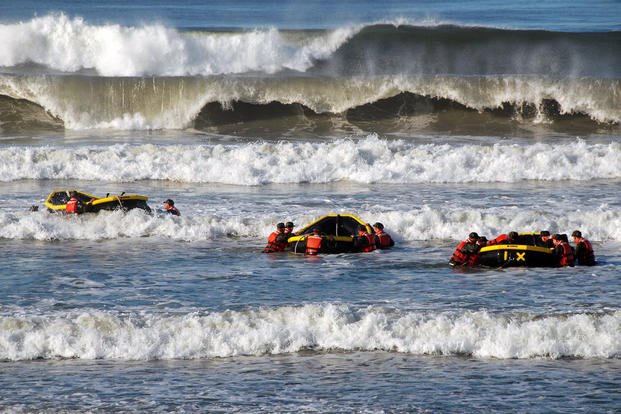After a long day at any special-ops training selection program, learning how to recover and prepare your body for the next day's events is critical to your success. This is from a recent email from a future BUD/S student.
Stew -- Can you and Jeff [Nichols] do a podcast on recovery at BUD/S? If not, what are the top five things I need to focus on with healing from all types of injuries from blisters, chafing, to soreness and overuse injuries?
Thanks, Sam.
Sam -- Great question. I wrote something similar several years ago, but there is some updated information that Jeff and I discussed in the Tactical Fitness Report podcast. These podcasts are often articles that I expand upon that are posted on Military.com Fitness.
If you want a quick laundry list, here are the things you need to learn how to do in order to lick your wounds at the end of the day and on the weekends at BUD/S.
These tips are standard for any special-ops training program as well as tough military training like Army and Marine Infantry.
Banned substances: The one thing you have to avoid at BUD/S is supplements. There is a rule that all supplements (even vitamins) are banned from use. So you will have to get extra protein and carbs in your food.
Chafing and blisters: After a long day and running and rucking in boots, usually both wet and sandy, blisters form. The first thing is to clean out the blister and get dry. Walk around in flip-flops or sandals the rest of the evening and use alcohol to clean and help dry out the wounds.
Pop the blister (if it is holding fluid) with a sterile pin (get your class medic to help). Some like to cut the dead skin off and clean under that, as there is likely sand under it. Then rub it with alcohol, and let it dry and toughen overnight. The following day, you will likely want to either duct-tape over the bandage, or you can try using a hefty amount of Vaseline on the blister with a bandage taped securely around the area.
Wear a thin pair of polyester and rayon blend socks over it and under the issue dive socks. This will help keep sand out. Then at the end of the day, clean it again, remove all Vaseline, apply alcohol again and let it dry out. This may take a few days. Make it to the weekend and never wear shoes and only cotton clothes to help air out the chafing as well. Chafing is similar. Keep it clean, dry and covered. Do not forget your sunscreen, too.
Soreness: Learning how to foam roll will save you so much pain from overuse injuries, such as tendinitis. Warming up before events with dynamic stretches and cooling down from the day with 10-15 minutes of stretching and icing goes a long way. Consider massages on weekends, but you may want to avoid deep-tissue massages as recovering from those may take a few days as well. No need to add more trauma to a traumatized body (see YouTube videos for ideas).
Near injuries: You will have borderline soreness and injuries that hurt through events. Getting a large bucket or garbage can and soaking in ice water is very helpful for both inflammation of soft-tissue pain and will increase blood flow to the cold region once out of the ice water. This helps with healing. Rest, ice and Motrin work, so talk to your class medic if anti-inflammatory medications are necessary for you.
Sleep and eat: The best recovery tool is sleep. Go to bed early and wake up refreshed as many days as you can. Sleep in on weekends and eat well. Never go to bed hungry. A bedtime snack high in protein and carbs is a good call, even in a bowl of cereal and some milk.
Eat snacks throughout the day and evening after the three daily meals you get at BUD/S. My favorite snack after dinner was beans and rice with canned chicken or tuna. During the day, I brought honey packets, baby carrots and apple slices with me in a bag and kept some in my locker for between events. Consider the ABDs of Nutrition, and do not forget hydration and electrolytes.
There is an entire fitness industry focused on recovery over the last 10 years, and Southern California is one of the leading areas in the United States on new technology. Take advantage and learn how compression clothing helps (not if you have blisters or chafing). Also consider Sensory Deprivation Float Pods for relaxing and decompressing.
If you need the poor man's option, here are the recommendations:
Ice bucket, alcohol, Vaseline, big bandages/tape and foam roller are a bare minimum to help you with recovery after a tough week of spec-ops training.
Stew Smith is a former Navy SEAL and fitness author certified as a Strength and Conditioning Specialist (CSCS) with the National Strength and Conditioning Association. Visit his Fitness eBook store if you're looking to start a workout program to create a healthy lifestyle. Send your fitness questions to stew@stewsmith.com.
Want to Learn More About Military Life?
Whether you're thinking of joining the military, looking for fitness and basic training tips, or keeping up with military life and benefits, Military.com has you covered. Subscribe to Military.com to have military news, updates and resources delivered directly to your inbox.



















